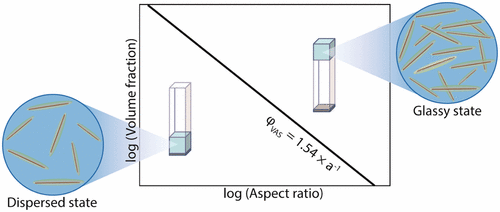Our official English website, www.x-mol.net, welcomes your
feedback! (Note: you will need to create a separate account there.)
Formation of Colloidal Nanocellulose Glasses and Gels
Langmuir ( IF 3.7 ) Pub Date : 2017-09-11 00:00:00 , DOI: 10.1021/acs.langmuir.7b01832 Malin Nordenström 1 , Andreas Fall 1 , Gustav Nyström 2 , Lars Wågberg 1
Langmuir ( IF 3.7 ) Pub Date : 2017-09-11 00:00:00 , DOI: 10.1021/acs.langmuir.7b01832 Malin Nordenström 1 , Andreas Fall 1 , Gustav Nyström 2 , Lars Wågberg 1
Affiliation

|
Nanocellulose (NC) suspensions can form rigid volume-spanning arrested states (VASs) at very low volume fractions. The transition from a free-flowing dispersion to a VAS can be the result of either an increase in particle concentration or a reduction in interparticle repulsion. In this work, the concentration-induced transition has been studied with a special focus on the influence of the particle aspect ratio and surface charge density, and an attempt is made to classify these VASs. The results show that for these types of systems two general states can be identified: glasses and gels. These NC suspensions had threshold concentrations inversely proportional to the particle aspect ratio. This dependence indicates that the main reason for the transition is a mobility constraint that, together with the reversibility of the transition, classifies the VASs as colloidal glasses. If the interparticle repulsion is reduced, then the glasses can transform into gels. Thus, depending on the preparation route, either soft and reversible glasses or stiff and irreversible gels can be formed.
中文翻译:

胶态纳米纤维素玻璃和凝胶的形成
纳米纤维素(NC)悬浮液可以在非常低的体积分数下形成刚性的跨度停滞状态(VAS)。从自由流动的分散体到VAS的过渡可能是颗粒浓度增加或颗粒间排斥力降低的结果。在这项工作中,研究了浓度引起的跃迁,特别关注颗粒长径比和表面电荷密度的影响,并尝试对这些VAS进行分类。结果表明,对于这些类型的系统,可以确定两种大致状态:玻璃和凝胶。这些NC悬浮液的阈值浓度与颗粒长宽比成反比。这种依赖性表明,过渡的主要原因是迁移率限制,它与过渡的可逆性一起,将增值服务分类为胶体眼镜。如果减少颗粒间的排斥力,则玻璃可以转变成凝胶。因此,取决于制备途径,可以形成软的和可逆的玻璃或坚硬的和不可逆的凝胶。
更新日期:2017-09-11
中文翻译:

胶态纳米纤维素玻璃和凝胶的形成
纳米纤维素(NC)悬浮液可以在非常低的体积分数下形成刚性的跨度停滞状态(VAS)。从自由流动的分散体到VAS的过渡可能是颗粒浓度增加或颗粒间排斥力降低的结果。在这项工作中,研究了浓度引起的跃迁,特别关注颗粒长径比和表面电荷密度的影响,并尝试对这些VAS进行分类。结果表明,对于这些类型的系统,可以确定两种大致状态:玻璃和凝胶。这些NC悬浮液的阈值浓度与颗粒长宽比成反比。这种依赖性表明,过渡的主要原因是迁移率限制,它与过渡的可逆性一起,将增值服务分类为胶体眼镜。如果减少颗粒间的排斥力,则玻璃可以转变成凝胶。因此,取决于制备途径,可以形成软的和可逆的玻璃或坚硬的和不可逆的凝胶。











































 京公网安备 11010802027423号
京公网安备 11010802027423号